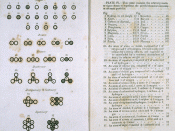An Atom is the smallest unit into which matter can be divided without the release of electrically charged particles. It also is the smallest unit of matter that has the characteristic properties of a chemical element. As such, the atom is the basic building block of chemistry.
John Dalton -
John Dalton developed the first useful atomic theory of matter around 1803. Whilst studying meteorology, Dalton concluded that evaporated water exists in air as an independent gas. Solid bodies can't occupy the same space at the same time, but clearly water and air could. If the water and air were composed of discrete particles, Dalton thought that evaporation might be viewed as a mixing of water particles with air particles. He performed a series of experiments on mixtures of gases to determine what effect properties of the individual gases had on the properties of the mixture as a whole. While trying to explain the results of those experiments, Dalton developed the theory that the sizes of the particles making up different gases must be different.
Dalton's atomic theory rests on the following claims:
1. All matter consists of tiny particles. The existence of atoms was first suggested more that 2000 years before Dalton's birth. Atoms remained pure speculation through most of this time, although Newton used arguments based on atoms to explain the gas laws in 1687.
2. Atoms are indestructible and unchangeable. Atoms of an element cannot be created, destroyed, broken into smaller parts or transformed into atoms of another element. Dalton based this theory on the law of conservation of mass and on centuries of experimental evidence.
With the discovery of subatomic particles after Dalton's time, it became apparent that atoms could be broken into smaller parts. The discovery of nuclear processes showed that it was even possible...


Nice essay
This essay was quite good good explaination of how knowledge of the atom was formed. Nice to see some linkages in the essay from thomson to rutherford interesting..good essay!!
1 out of 1 people found this comment useful.